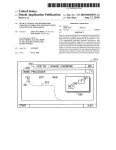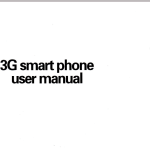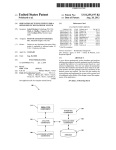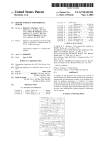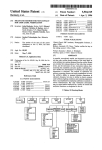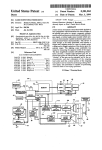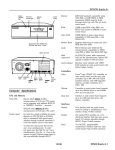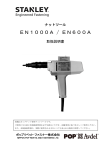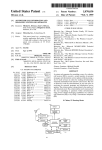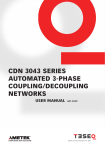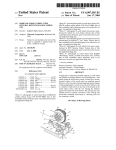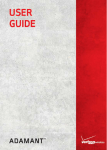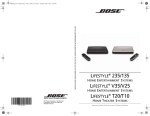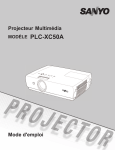Download Context-aware augmented communication
Transcript
US 20120137254A1
(19) United States
(12) Patent Application Publication (10) Pub. No.: US 2012/0137254 A1
CUNNINGHAM et al.
(54)
(75)
(43) Pub. Date:
May 31, 2012
CONTEXT-AWARE AUGMENTED
COMMUNICATION
(51)
Publication Classi?cation
Int CL
G06F 3/048
(2006.01)
Inventors:
(52)
US. Cl. ...................................................... .. 715/835
BOB CUNNINGHAM, Pittsburgh,
PA (US); DAVID EDWARD LEE,
Pittsburgh, PA (US)
(57)
ABSTRACT
Systems and methods of providing electronic features for
.
(73) Asslgnee:
creatin
DYNAVOX SYSTEMS LLC’
context-aware vocabula
su
estions for an elec
tronic device include providingrgi gragghical user interface
Pmsburgh, PA (Us)
design area having a plurality of display elements. An elec
tronic device user may be provided automated context-aware
(21) App1_ NO;
13/304,022
(22) Filed:
NOV- 23: 2011
analysis from information from plural sources including
GPS, compass, speaker identi?cation (i.e., voice recogni
tion), facial identi?cation, speech content determination, user
speci?cations, speech output monitoring, and software navi
gation monitoring to provide a selectable display of sug
Related US Application Data
(60) Provisional application No. 61/417,596, ?led on Nov.
29, 2010.
EMAIL
INTERNET
MUSIC
,
.
..
gested vocabulary, previously stored Words and phrases, or a
keyboard as input options to create messages for text display
and/or speech generation. The user may, optionally, manually
specify a context.
PICTURES
CALENDAR
n
202
Browse
Folders
D
200
MY
WORDS
MY
PHRASES
D
KEYBOARD
Patent Application Publication
May 31, 2012 Sheet 1 0f 4
US 2012/0137254 A1
-I
.m
2HSC
"CC?
N
P_l
S
R
.r
MG
AA_CNTT0_
.EPO0
001
.A
?wm
wwn,m“
CDm
Fm
"R
TT
_m.
EWDOA
ADC_
D
_
H
H
In
_E
CE
"w
mm
nm
mm
mm
v%v“m
w Jfo
“T
m
M‘
How
n1
mm
m
@A
W
HNm
RD
_
_
wC
00
H
.D
n
0G
UN
"m
m
w
m
NMA
“W
m
"WB
D.SS.EGN Um
H
Q
0AM
0P Twm
AWAR
CMA_
n
EAMO1RU
m_
m
_0
S
mm
w
H,
E
D
T
_
(um
_.1EM
W
T
.l.
PA
E
M
M
"
NM
N
B_ M.A
N
Il|II."lI|.I|
00
E
AND
H0_
W
6.MC
N
an3N0A
W
EUT
M_
LANGUAGE SUGGESTIONS
Fig. 1A
100
m
E
n
“
Patent Application Publication
May 31, 2012 Sheet 2 0f 4
US 2012/0137254 A1
150
ELECTRONICALLY GATHER ONE OR MORE
DATA ELEMENTS (E.G., USER SPECIFICATION,
SPEAKER/VOICE IDENTIFICATION, FACIAL
RECOGNITION, GPS/COMPASS DATA, AND/OR
GEOLOCATION INFORMATION) FOR USE IN
152
N
DETERMINING A COMMUNICATION CONTEXT
V
ELECTRONICALLY ANALYZE SELECTED OF
154
THE GATHERED DATA ELEMENTS TO
N
MANUALLY OR AUTOMATICALLY DETERMINE
A COMMUNICATION CONTEXT
V
ELECTRONICALLY STORE SPEECH OUTPUT
156
AND/ORSOFTWARE NAVIGATION LOCATIONS /\/
MADE WHILE OPERATING IN THE
DETERMINED COMNIUNICATION CONTEXT
ELECTRONICALLY PROCESS INFORMATION
15 3
IDENTIFYING THE COMMUNICATION CONTEXT /\./
AND/OR STORED SPEECH OUTPUT AND/OR
SOFTWARE NAVIGATION LOCATION
INFORMATION TO MAKE LANGUAGE
SUGGESTIONS FOR POTENTIAL USE IN SUCH
COMIVIUNICATION CONTEXT
Fig. 1B
Patent Application Publication
EMAIL
May 31, 2012 Sheet 3 of4
INTERNET
PICTURES
US 2012/0137254 A1
CALENDAR
GAMES
@
202
RETURN
I
ESTES
WS'JDS
200 N
/
PHRMISES
KEYBMRD
.
Hg. 2
310
312
r
PAUSE
ll
@
/
AUDIO
LIVE
VIDEO
INPUT
VIEW
304
GPS
302
306
coNTExT
MY
COMPASS
PHRASES
AWARE
ONIOFF
l
~
\/
@
30B
KEYBOARD
wgf‘lrlls
LOgEgl-ON n\-/
Fig. 3
m 300
Patent Application Publication
May 31, 2012 Sheet 4 of4
US 2012/0137254 A1
402
SOUND
Composed Massage
F
i i-il
MAIN
_
MENu
406
MY
\
DISPLAY
SUGGESTED VOCABULARY
404
PHRAsEs
CONTEXT
VOCAB.
BILTMORE HOUSE
GARDENS
WINERY
408
STABLES
1 KEYBOARD
MY
AsHEvILLE
WORDS
NORTH CAROLINA
AMERIcA's LARGEST PRIVATE HOME
FRENCH BROAD RIVER
Fig 4
mm
505
51 0a
51 0b
505
|
Touch
l
GPS
I
COMPASS
5(|]8
|
Screen
Device
Device
r‘mcmpho?e
500
/
Power Button!
Switch
/ 501
Central Computing Device
Antenna
.-— 515
Battery
,.
Memory
503
Nelwork/
Device
Processor(s)
Commm
/- 520
lnterface{s}|
L‘ 5043
Cellular
-
Phone or RF ,- 516
Memory
Device
Device
507
,-
Peripheral
Device
[g
|
509
L 504b
Memory
Device
L 5040
_ 5
Display
512"
Device
_
VDIume
—
,- 522
comm]
?ztwork
8pIer
t 502
Speakers
’_ 514
Wireless
Camera
/_ 519
_,_ 518
May 31, 2012
US 2012/0137254 A1
CONTEXT-AWARE AUGMENTED
COMMUNICATION
[0008]
As the accessibility and communications function
ality of SGDs continues to increase, users need to be able to
communicate With enhanced vocabulary and symbol set
CROSS-REFERENCE TO RELATED
APPLICATIONS
options. Conventional ?xed sources or databases of such
communication elements are typically lacking in dynamic
development of such elements that could enhance SGD com
[0001] N/A
STATEMENT REGARDING FEDERALLY
SPONSORED RESEARCH OR DEVELOPMENT
[0002] N/A
munications functionality.
[0009] In light of the specialiZed utility of speech genera
tion devices and related interfaces for users having various
levels of potential disabilities, a need continues to exist for
re?nements and improvements to context sensitive commu
nications. While various implementations of speech genera
PRIORITY CLAIM
tion devices and context recognition features have been
[0003] This application claims the bene?t of priority of
previously ?led US. Provisional Patent Application entitled
encompass all of the desired characteristics hereafter pre
developed, no design has emerged that is knoWn to generally
sented in accordance With aspects of the subject technology.
“CONTEXT AWARE AUGMENTED COMMUNICA
TION” assigned U.S. Ser. No. 61/417,596, ?led on Nov. 29,
2010, and Which is fully incorporated herein by reference for
all purposes.
BACKGROUND
BRIEF SUMMARY
[0010]
In general, the present subject matter is directed to
various exemplary speech generation devices (SGDs) or
other electronic devices having improved con?gurations for
providing selected AAC features and functions to a user.
[0004] The presently disclosed technology generally per
tains to systems and methods for providing alternative and
More speci?cally, the present subject matter provides
improved features and steps for creating context-speci?c
augmentative communications (AAC) steps and features
message item choice selections (e. g., for such message items
such as may be available in a speech generation device or
other electronic device.
as vocabulary, Words, phrases, symbols and the like) for
[0005] Electronic devices such as speech generation
devices (SGDs) or Alternative and Augmentative Communi
inclusion in composing messages.
[0011] In one exemplary embodiment, a method of provid
ing automatic context identi?cation is provided. According to
cation (AAC) devices can include a variety of features to
this automatic method, one or more data elements for use in
assist With a user’s communication. Such devices are becom
determining a communication context are electronically
ing increasingly advantageous for use by people suffering
gathered. Exemplary data elements may correspond to such
from various debilitating physical conditions, Whether result
items as user speci?cation, speaker/voice identi?cation,
ing from disease or injuries that may prevent or inhibit an
facial recognition, speech content, GPS/compass data and/or
af?icted person from audibly communicating. For example,
many individuals may experience speech and learning chal
geolocation information. One or more data gathering soft
Ware modules such as a speaker identi?cation (i.e., voice
lenges as a result of pre-existing or developed conditions such
recognition) module, facial recognition module, GPS data
module, compass data module, geolocation information
module, speech recognition (i.e., speech content determina
as autism, ALS, cerebral palsy, stroke, brain injury and others.
In addition, accidents or injuries suffered during armed com
bat, Whether by domestic police o?icers or by soldiers
engaged in battle Zones in foreign theaters, are sWelling the
population of potential users. Persons lacking the ability to
communicate audibly can compensate for this de?ciency by
the use of speech generation devices.
[0006] In general, a speech generation device may include
an electronic interface With specialiZed softWare con?gured
to permit the creation and manipulation of digital messages
that can be translated into audio speech output or other out
going communication such as a text message, phone call,
e-mail or the like. Messages and other communication gen
erated, analyZed and/or relayed via an SGD or AAC device
may often include symbols and/or text alone or in some
combination. In one example, messages may be composed by
a user by selection of buttons, each button corresponding to a
graphical user interface element composed of some combi
nation of text and/ or graphics to identify the text or language
element for selection by a user.
[0007] Current advancements for speech generation
devices have afforded even more integrated functionality for
their users. For example, some SGDs or other AAC devices
are con?gured not only for providing speech-based output but
also for playing media ?les (e. g., music, video, multi-media,
etc.), providing access to the Internet, and/or even making
telephone calls using the device.
tion) module, bar code data module and user speci?cations
module may be used to for communicator identi?cation and/
or location identi?cation.
[0012]
Selected pieces of the gathered data elements are
then electronically analyZed either to determine that a user
has manually speci?ed a communications context (e.g., by
selecting a precon?gured context Within the user speci?ca
tions module) or to implement the automatic determination of
a communication context based on the gathered data ele
ments. In general, the manually or automatically determined
communication context provides a pro?le of a user and/or one
or more of the user’s communication partners and/or one or
more of the locations, speech, device speci?cations or other
related aspects associated With device use.
[0013] The speci?cs of the pro?le are then used to develop
communicator-speci?c and/or location-speci?c message
items (e.g., Words, phrases, symbols, pictures, and other lan
guage items) for display to a user for selectable inclusion in
messages being composed by the user on an AAC device.
Additional message items or other language suggestions may
be provided from a local or online search relating to identi?ed
items de?ning a communication context (e.g., determined
location, determined communicator name, etc.) Once par
ticular message items are identi?ed for suggestion to a user,
such message items may be provided as selectable output to a
May 31, 2012
US 2012/0137254 A1
user. More particularly, such items may be displayed on a
screen associated With the AAC device, preferably in an array
of scrollable and/or selectable items. The displayed message
items ultimately can be used by a user for composing mes
sages for display and/or conversion to synthesized or digital
?le reproduced speech and/or remote communication to
another via text, email, or the like.
[0014] In other more particular exemplary embodiments, a
communication context data structure is provided that stores
not only information identifying a context, but also a history
of speech output made in that context and/or a history of
softWare navigation locations made in that context. This addi
tional information can be electronically stored for use by a
user. In certain embodiments, GPS and compass information
input de?ning the various features of the graphical user inter
face and to initiate a graphical user interface having such
features.
[0018] In more particular exemplary embodiments of an
electronic device, the electronic device may comprise a
speech generation device that comprises at least one input
device (e. g., touchscreen, eye tracker, mouse, keyboard, joy
stick, sWitch or the like) by Which an AAC device user may
specify a context manually. In certain embodiments, the elec
tronic device may be provided With a camera or other visual
input means and/ or a microphone or other audio input means
to provide analysis for facial and speech recognition. In other
instances, the electronic device may be provided With a bar
code scanner to read 2D matrix or other barcodes Within a
may be used in conjunction With geolocation softWare for
determining physical location and place information to sug
user’s environment to assist With determining a communica
tion context. In still further embodiments, an electronic
gest language to use in a particular location context.
device may be provided With at least one speaker for provid
ing audio output. In such embodiments, the at least one pro
cessing device can be further con?gured to associate selected
[0015] It should be appreciated that still further exemplary
embodiments of the subject technology concern hardWare
and softWare features of an electronic device con?gured to
perform various steps as outlined above. For example, one
exemplary embodiment concerns a tangible computer read
able medium embodying computer readable and executable
instructions con?gured to control a processing device to
implement the various steps described above or other combi
nations of steps as described herein.
[0016] In one particular exemplary embodiment, a tangible
computer readable medium includes computer readable and
executable instructions con?gured to control a processing
device to analyZe faces and/ or speech to recogniZe individual
communicators (i.e., the device user and/or communication
partners With Whom the user is communicating) and to sug
gest language or other message items appropriate to the iden
ti?ed individual. In further embodiments, the executable
instructions are con?gured to cause the display of identi?ed
ones of the plurality of display elements With one or more
given electronic actions relative to the communication of
speech-generated message output provided by the electronic
device.
[0019] Additional aspects and advantages of the disclosed
technology Will be set forth in part in the description that
folloWs, and in part Will be obvious from the description, or
may be learned by practice of the technology. The various
aspects and advantages of the present technology may be
realiZed and attained by means of the instrumentalities and
combinations particularly pointed out in the present applica
tion.
BRIEF DESCRIPTION OF THE DRAWINGS
[0020]
The accompanying draWings, Which are incorpo
rated in and constitute a part of this speci?cation, illustrate
context-speci?c Words and phrases in a scrollable, selectable
one or more embodiments of the presently disclosed subject
format on a display screen. In certain embodiments, the
executable instructions are con?gured to employ identi?ed
matter. These draWings, together With the description, serve
to explain the principles of the disclosed technology but by no
context-speci?c terms as search terms in a database and to
means are intended to be exhaustive of all of the possible
display the results of such search terms as additional select
able Words and phrases. In selected embodiments, the com
manifestations of the present technology.
[0021] FIG. 1A provides a schematic diagram of exemplary
puter readable medium includes computer readable and
softWare modules for use in a computeriZed method of pro
executable instructions con?gured to apply facial recognition
and voice identi?cation algorithms to previously recorded
viding electronic features for creating context-aWare lan
guage suggestions for an electronic device;
[0022] FIG. 1B provides a How chart of exemplary steps in
and/ or real time data to identify individuals.
[0017] In a still further example, another embodiment of
the disclosed technology concerns an electronic device, such
as but not limited to a speech generation device, including
such hardWare components as at least one electronic input
device, at least one electronic output device, at least one
processing device and at least one memory. The at least one
electronic output device can be con?gured to display a plu
rality of graphical user interface design areas to a user,
Wherein a plurality of display elements are placed Within the
graphical user interface design areas. The at least one elec
tronic input device can be con?gured to receive electronic
input from a user corresponding to data for selecting one or
more of a number of display element types to be placed Within
the graphical user interface area. The at least one memory
a method of providing electronic features for creating con
text-aWare language suggestions for an electronic device;
[0023] FIG. 2 depicts a ?rst exemplary embodiment of a
graphical user interface area With a plurality of display ele
ments in accordance With aspects of the presently disclosed
technology;
[0024] FIG. 3 depicts a second exemplary embodiment of a
graphical user interface area With a plurality of display ele
ments in accordance With aspects of the presently disclosed
technology;
[0025] FIG. 4 depicts a third exemplary embodiment of a
graphical user interface area With a plurality of display ele
ments in accordance With aspects of the presently disclosed
may comprise computer-readable instructions for execution
technology; and,
by said at least one processing device, Wherein said at least
one processing device is con?gured to receive the electronic
[0026] FIG. 5 provides a schematic vieW of exemplary
hardWare components for use in an exemplary speech gen
May 31, 2012
US 2012/0137254 A1
eration device for providing context aware vocabulary sug
gestion features in accordance With aspects of the presently
disclosed technology.
DETAILED DESCRIPTION OF THE PREFERRED
EMBODIMENTS
[0027]
Reference noW Will be made in detail to the pres
ently preferred embodiments of the disclosed technology, one
or more examples of Which are illustrated in the accompany
ing draWings. Each example is provided by Way of explana
tion of the technology, Which is not restricted to the speci?cs
of the examples. In fact, it Will be apparent to those skilled in
the art that various modi?cations and variations can be made
in the present subject matter Without departing from the scope
or spirit thereof. For instance, features illustrated or described
as part of one embodiment, can be used on another embodi
ment to yield a still further embodiment. Thus, it is intended
that the presently disclosed technology cover such modi?ca
tions and variations as may be practiced by one of ordinary
skill in the art after evaluating the present disclosure. The
the modules provided in FIG. 1A. Similarly, the steps pro
vided in FIG. 1B may be performed in the order shoWn in such
?gure or may be modi?ed in part, for example to exclude
optional steps or to perform steps in a different order than
shoWn in FIG. 1B.
[0031] The modules shoWn in FIG. 1A and the steps shoWn
in FIG. 1B illustrate various aspects of an electronically
implemented computer-based process. Computerized pro
cessing of electronic data in a manner as set forth in FIG. 1B
may be performed by a special-purpose machine correspond
ing to some computer processing device con?gured to imple
ment such electronically implemented process. For example,
a hardWare embodiment is shoWn in FIG. 5 Which may be
used to implement the subject process, particularly Where the
modules shoWn in FIG. 1A are stored in one or more of the
memory/media devices shoWn in FIG. 5.
[0032] Referring noW to FIG. 1B, a ?rst exemplary step 152
same numerals are assigned to the same or similar compo
in accordance With the present automated method corre
sponds to electronically gathering one or more data elements
for use in determining a communication context. Exemplary
data elements may correspond to such items as user speci?
nents throughout the draWings and description.
cation, speaker/voice identi?cation, facial recognition,
[0028] Referring noW to the draWings, various aspects of a
system and method of providing electronic features for cre
ating context-aWare message item suggestions for inclusion
mation. One or more softWare modules 101 as shoWn in FIG.
in composing messages for an electronic device are disclosed.
In general, the subject technology provides features by Which
a user can be provided With a context-aWare library of com
municator-speci?c and/ or location-speci?c message items
such as Words, phrases, symbols, vocabulary or other lan
guage elements for inclusion in composing messages. Such
speech content, GPS/ compass data and/ or geolocation infor
1A may be con?gured for accomplishing the data gathering
step 152. Exemplary data gathering softWare modules may
include, Without limitation, a speaker identi?cation (i.e.,
voice recognition) module 102, facial recognition module
104, GPS data module 106, compass data module 108, geolo
cation information module 110, speech recognition (i.e.,
speech content determination) module 112, bar code data
feature alloWs the user to quickly interact With identi?ed
individuals and comment on people, facts or information
module 113 and user speci?cations module 114. Each of
these information gathering modules Will be described more
related to the identi?ed individuals and/or to a present or
previously visited location or other related location or loca
fully beloW.
tion related places, events, or other information.
generally may be used for communicator identi?cation,
including but not limited to the speaker identi?cation module
[0029]
The ability to provide customiZed Word and phrase
selection libraries for an electronic device provides a variety
of advantages. For example, interfaces can be created that
provide enhanced response rates for alternative and augmen
tative communications (AAC) device users Wishing, for
example, to engage in a discussion of a location being visited
for the ?rst time Which includes Words and phrases that are
generally neW or foreign to the vocabulary normally used or
currently available to the user. By providing a context-aWare
vocabulary from Which the user may select Words or phrases
speci?c to her location the user Will be able to more readily
compose messages relating to the material. Context-aWare
libraries Will also reduce the cognitive load for the user and
[0033]
One or more of the data gathering modules 101
102 and/ or the facial recognition module 104 and/or the
speech recognition module 112. It should be appreciated that
the data gathering modules described above may be useful for
identifying communicators including not only the user of an
AAC device, but additionally or alternatively one or more
communication partners With Whom a user is communicat
ing. For example, speaker voice recognition, speech recogni
tion and/or facial recognition can be variously used to identify
just the user, just the communication partner(s), or both par
ties to a conversation. This versatility can help provide a
broader range of customiZation in accordance With the dis
closed context-speci?c communications options by creating a
improve the overall learning experience.
communication context that is dependent on one or more of a
[0030]
variety of individuals Whom are party to an electronically
tracked conversation using an AAC device.
[0034] With more particular reference to the data gathering
modules 101 that may be used for communicator identi?ca
tion, speaker identi?cation module 102 can be used to iden
tify a user and/or communication partner via voice recogni
tion techniques. Such module 102 may correspond to an
FIGS. 1A and 1B provide schematic diagrams
related to a method of providing electronic features for cre
ating an automated customiZed context-aWare message item
choices interface for an electronic device in accordance With
present technology. FIG. 1B provides a How chart 150 of
exemplary steps in such a method, While FIG. 1A provides a
schematic overvieW 100 of exemplary softWare modules that
modules 101, a communication context data structure 111
audio speaker identi?cation program via voice recognition
softWare analysis of audio received by, for example, micro
phone 508 (FIG. 5). Speaker identi?cation via voice recog
nition can be implemented, for example, by comparing gath
ered voice samples to a prerecorded library of knoWn
and a data processing module 121. Various embodiments of
the presently disclosed technology may include some or all of
samples. Identi?cation of a user and/or communication part
ner may also be made via facial recognition module 104 in
can combine to implement selected of the steps such as those
shoWn in FIG. 1B and those otherWise disclosed in the present
application. In general, the softWare modules of FIG. 1A are
categoriZed in one of three general areas4data gathering
May 31, 2012
US 2012/0137254 A1
conjunction with facial recognition software and an input
the user with relevant location-speci?c message item choices
from, for example, camera 519 (FIG. 5). Still further, analysis
as an aid to message composition. For example, a search for
of the words, phrases, etc. contained in a speech sample can
be used to determine speech content which may also be used
to identify a user and/or communicator. For example, speech
recognition module 112 can use speech-to-text conversion
the Biltmore House would reveal geolocation information
110 including, for example, the name of the river passing
software to convert a user’s speech into resultant text to iden
tify the speaker based on the speaker’s conversation content.
In an exemplary, non-limiting, implementation, Dragon
Naturally SpeakingTM software by Nuance Communications,
Inc. may be employed to provide speech-to-text conversion to
provide text usable in a search engine to identify the speaker.
Similar text-to-speech conversion software may be used in
the speech output monitor data module 116, which is
along the property (French Broad River), and the fact that
there are a winery, stables, and gardens associated with the
property. Such a search may also reveal that the Biltmore
House is America’s largest private home. As will be described
later with respect to FIG. 4, in accordance with the present
technology, each of these items may be displayed as location
speci?c vocabulary suggestions to an AAC device user to
assist the user in carrying on a conversation. Corresponding
pictures, symbols, phrases and/or other message items may
described later in more detail.
also be developed for presentation to a user.
[0039] A still further data gathering module 101 in accor
[0035]
dance with the presently disclosed technology more particu
In any instance of communicator identi?cation, fur
ther processing of an obtained identi?cation of a user and/or
larly concerns a bar code data module 113. Bar code data
communication partner such as by search of online or local
databases will provide the user with relevant communicator
speci?c message item choices as an aid to message compo
sition. Local databases could be stored, for example, in one of
module 113 may correspond to the software interfacing fea
tures and resultant data provided when an AAC device
includes an integrated bar code reader or when a bar code
memory devices 504a, 504b, and/or 5040 (FIG. 5), and online
databases may correspond to those provided by an online
(e.g., using a bar code reader/ scanner as peripheral device 507
in FIG. 5). Bar codes readable by such a bar code reader/
search engine, for example without limitation, Google,
BingTM, SnapTM, Yahool®, and Lycos®, that may be accessed
scanner may be placed within a user’s environment and be
associated with one or more identifying items, including but
via the Internet using onboard Network Communication
Interface 520 (FIG. 5) of AAC device 500.
[0036] To appreciate the types of communicator-speci?c
language elements or related message items (e.g., pictures,
symbols, phrases and the like) that may be developed in
accordance with the disclosed technology, consider the iden
ti?cation of a communication partner as a particular friend or
acquaintance of the AAC device user. A search of a previously
generated local database may result in presenting the user
with a communicator-speci?c message item list including
such as the identi?ed communicator’s spouse’s name, chil
dren’s names, pet’s name, home town, job title, hobbies or
other related information. Symbols and/or phrases or other
language elements or message items related to these commu
nicator-speci?c vocabulary choices may also be provided.
reader is attached as a peripheral device to an AAC device
not limited to people, things, places, events and the like. Each
bar code may then either store additional information associ
ated with its identifying item or may contain information
about an electronic link (e.g., website URL, RF transmission
connection information, etc.) to such additional information.
Bar code input information may particularly correspond to
information used for communicator identi?cation and/or
location identi?cation aspects associated with identifying a
communication context.
[0040]
For example, each friend or family member of an
AAC device user may have a bar code associated therewith
such that the AAC device user can scan a communicator’s
associated barcode when the AAC device user is interacting
with such communicator. This provides the AAC device user
(and the user’s AAC device) with an af?rmative identi?cation
[0037] Referring still to FIG. 1A, some other data gathering
modules 101 may generally include software features for
of the communicator, and in some cases an identi?cation that
identifying location information, and include such examples
voice recognition, speech recognition, and the like. Under
as a GPS data module 106, compass data module 108, and
standing that bar codes may not be available for every person
or place, one of ordinary skill in the art will appreciate that
geolocation information module 110. Such modules may be
is even more reliable than other identi?cation means such as
used individually and/or collectively to provide information
multiple identi?cation modules in addition to barcode input
regarding a user’s current or previously visited locations.
modules may also be employed in an AAC device of the
Location information can also be obtained by triangulation
presently disclosed technology. In addition to identifying the
methods using cellular telephone tower locations using cel
communicator, each bar code read by a bar code reader/
lular phone device 510 (FIG. 5). In one example, if a GPS
receiver associated with an AAC device provided location
variety of information associated with that individual. For
scanner associated with an AAC device may thus provide a
compass, for example, a ?uxgate magnetometer compass,
example, a bar code may provide not only the name of an
individual communicator, but also information such as that
also associated with the AAC device indicated you were
person’s birthday, the names of his family members, his hob
facing in a west north west (WNW) direction, a search of, for
bies, address, and the like. The AAC device user thus has
ready access to important information about such person, and
information of 35° 32' 25.56" N 82° 38' 06.46" W and a
example, Google Earth®, Google Maps®, or MapQuest®
online, or a mapping database local to the AAC device, would
reveal that you are standing in the front lawn of the Biltmore
House in Asheville, NC. and you are looking at the house.
[0038] The location information gathered via one or more
of the GPS data module 106, compass data module 108, and
geolocation information module 110 may be ultimately pro
cessed similar to the communicator identi?cation informa
tion such as by search of online or local databases to provide
can then use that information in communicating with that
person. This information may be encoded directly within the
optical parameters of a barcode. Or alternatively, each bar
code provides information to a communication link (e.g., an
item- speci?c URL) where information about a communicator
or other item can be stored and continually updated.
[0041] The types of bar codes and encoding used in accor
dance with bar code data module 113 and any associated
May 31, 2012
US 2012/0137254 A1
reader/ scanner hardware may be in accordance With a variety
of known standards or standards as developed in the future
that provide a suitable optical machine-readable representa
tion of data that is speci?c to each coded item. TWo-dimen
sional (2D) or matrix barcode technology may be particularly
applicable for use With the disclosed technology since such
bar codes generally have a higher data representation capa
bility than one-dimensional (l D) barcodes, although 1D bar
codes are not excluded. Non-limiting examples of matrix/ 2D
barcodes for use With the disclosed technology include QR
codes, stacked barcodes, multi-segment barcodes, high
capacity color barcodes and the like.
[0042] Further With respect to step 152 of FIG. 1B, addi
tional information that may be gathered for use in subse
quently determining a communication context may include a
user speci?cations module 114. In some instances, the user
manually or automatically determine a communication con
text. The determined communication context may then be
stored as a separate data variable represented by the commu
nication context identi?cation information 120 Within com
munication context data structure 111. In general, communi
cation context identi?cation information 111 provides a
pro?le of a user and/or one or more of the user’s communi
cation partners and/or one or more of the locations, speech,
device speci?cations or other related aspects associated With
device use. The speci?cs of the pro?le are then used to
develop communicator-speci?c and/or location-speci?c mes
sage items for display to a user for selectable inclusion in
messages being composed by the user on an AAC device.
[0045] Referring still to FIGS. 1A and 1B, it should be
appreciated that additional information may be gathered once
speci?cations module 114 may include data corresponding to
a communication context has been determined. More particu
a user’s manual speci?cation of a particular context Within
Which the user Wants to operate. For example, a user’s AAC
larly, step 156 of FIG. 1B indicates that speech output and/or
softWare navigation locations made While operating in a
given communication context (as determined in step 154)
may also be electronically stored. Such data is indicated in
FIG. 1A as the modules for monitoring the speech output 116
device may be adapted With several different precon?gured
communication contexts based on different people With
Whom the user interacts (e.g., spouse, caregiver, friends, etc.)
or different places (e.g., home, Work, school, etc.). AnAAC
of theAAC device as Well as the softWare navigation data 118,
device can be provided With selectable softWare features for
i.e., navigation steps a user has folloWed during the operation
the user to manually select a communications context for
of the AAC device. Both of these features may be used to
these given operational environments. The user speci?cations
provide input that may be used to further expand vocabulary
module 114 can then receive such user-selected context infor
suggestions offered to the AAC device user. For example, if
mation and utiliZe it to automatically toggle a precon?gured
communication context as opposed to automatically deter
mining the best context based on other analyZed information
(e.g., communicator identi?cation information and/or loca
the user has caused the AAC device to ask a question of her
tion information.)
[0043] With further respect to user speci?cations module
114, the user speci?cations module may track the operational
features of an AAC device selected by a user. It should be
appreciated that an AAC device user may select certain opera
tional features, and the Way those features are con?gured may
conversation partner about the Winery associated With the
Biltmore estate, vocabulary suggestions listing different
types of Wine or Wine related terms may be included in a
vocabulary suggestions list. In like manner, if a user has used
the AAC device softWare to specify cellular toWer location
determination as opposed to more accurate GPS location,
vocabulary suggestions may be expanded to cover more dis
tant locations, for example, doWntoWn Asheville, as opposed
to the more precise location of the laWn in front of the Bilt
indicate something about the user. For example, a user may
choose to operate his AAC device such that messages are
more House.
composed With text only, With symbols only, or With a com
bination of text and symbols. In another example, a user may
choose to operate his AAC device With one of many different
input options, such as but not limited to the “Touch Enter,”
may also be collected that is pertinent to the context in Which
anAAC device user may ?nd himself that may also be used in
“Touch Exit,” “Touch Auto Zoom,” “Scanning,” “Joystick,”
“Auditory Touch,” “Mouse Pause/Headtrackers,” “Morse
netWork communication interface 520 (FIG. 5) may be oper
ated in conjunction With either the GPS data 106 or triangu
Code,” and/or “Eye Tracking” access modes. In a still further
lation information based on cellular toWer locations to obtain
a local Weather report so that relevant context-aWare vocabu
example, the previously mentioned camera input may be
[0046]
It should be appreciated that additional information
conjunction With the present technology. For example, the
altered to permit selection of an external camera by Way of a
lary suggestions regarding, for example, an approaching
peripheral device 507 (FIG. 5) USB connection to the AAC
device. Other selection options may include selecting the use
thunderstorm may also be presented to the AAC device user.
[0047] Referring again to FIGS. 1A and 1B, once a com
munication context has been identi?ed in module 120, and
of GPS vs. triangulation via cellular toWers to obtain location
information. The context determination features of the pres
any additional information has been gathered in modules 116
ently disclosed technology may track the above exemplary
and 118, some or all of such data is provided to data process
operational features of an AAC device and other operational
features to help analyZe and determine the most appropriate
ing module 121. In data processing module 121 of FIG. 1A,
step 158 of FIG. 1B is implemented. Step 158 involves elec
communications context for a user.
tronically processing information identifying the communi
[0044]
cation context and/ or stored speech output and/or stored navi
gation location information to make language or other
message item suggestions for potential use in the determined
communication context. SoftWare instructions and rules for
processing data may be stored in the process data module 122
Regardless of the sources of information, including
the ones mentioned above as Well as other sources as may
become apparent to those of ordinary skill in the art from a
reading of the present disclosure, these information sources
all provide data to a communication context data structure
111 as shoWn in FIG. 1A. It is Within the con?nes of the
communication context data structure 111 that selected gath
ered data elements are analyZed per step 154 of FIG. 1B to
of FIG. 1A and the generated language suggestions may be
stored in module 124.As previously described, the processing
step 158 may involve conducting a local or online search
May 31, 2012
US 2012/0137254 A1
relating to identi?ed items de?ning a communication context
(e. g., determined location, determined communicator name,
[0052] With reference noW to FIG. 2, there is illustrated a
?rst exemplary embodiment of a graphical user interface area
200 With a plurality of display elements in accordance With
etc.)
In some embodiments, local and/ or online databases
aspects of the presently disclosed technology. As may be
may be con?gured With predetermined or adaptable links
among associated vocabulary elements to readily assist With
the suggestion of communicator-speci?c message and/or
seen, graphical user interface area 200 may correspond to an
initial interface area as presented upon poWer up of an AAC
location-speci?c message items. When links are adaptable, a
user can link Words for future presentation When in a given
Upon poWer up, graphical user interface area 200 provides a
communication context is determined. When speech output
NET, MUSIC, PICTURES, CALENDAR, GAMES, etc.,
and/ or location information is recorded in conjunction With a
and, in accordance With the present subject matter, a CON
TEXT selection button 202. Upon touching the CONTEXT
[0048]
communication context, vocabulary identi?ed from the
speech and/or location can be linked to the communication
context. For example, if location information helps identify as
part of the determined communication context that the user is
in Asheville, NC, then linked location-speci?c vocabulary
elements might include Asheville, North Carolina, Blue
device constructed in accordance With present technology.
number of selection item buttons including EMAIL, INTER
selection button 202, graphical user interface area 200 is
changed to display a CONTEXT graphical user interface area
300.
[0053] With reference to FIG. 3, there is illustrated a second
exemplary embodiment of a graphical user interface area 300
Ridge Parkway, Biltmore House, French Broad River and the
like. Having these location-speci?c message items readily at
With a plurality of display elements in accordance With
hand can facilitate a user’s communication regarding his
determined location. In another example, if a communicator
larly, graphical user interface area 300 provides an enlarged
is determined to be a user’s acquaintance Tommy and speech
output While Within that communication context frequently
references a dog named Spike and certain items related to the
presentation from Which vocabulary may be extracted in
aspects of the presently disclosed technology. More particu
screen area 302 on Which may be vieWed a live or recorded
accordance With present technology. Exemplary operational
presented as suggested message items to a user. In this fash
ion, While in a given communication context, some or all
selection buttons are provided to, for example, select from
buttons for a GPS 304, COMPASS 306, GEOLOCATION
308, AUDIO VIDEO INPUT 310, LIVE VIEW 312, and to
activate or disable the context-aWare vocabulary process via
CONTEXT AWARE ON/OFF 302. As is evident from an
speech output and softWare navigation locations can be
recorded and used to determine suggested language When
also available and provide other relevant operational options.
game of golf, then keyWords from such speech (e.g., “dog,”
“Spike,” “golf”) With optional symbols or pictures may be
inspection of FIG. 3, a number of other exemplary options are
next in the same communication context.
Those of ordinary skill in the art Will appreciate that other or
[0049] Once particular message items (e. g., Words,
phrases, symbols, pictures, and other language items) are
additional options may also be provided.
identi?ed for suggestion to a user, such message items may be
provided as output to a user. More particularly, such items
may be displayed on a screen associated With theAAC device,
preferably in an array of selectable items. In one example, a
scrollable, selectable format can be used on a display screen
for suggested message items. Additional aspects of hoW
exemplary language suggestions 124 may be presented to an
ACC device user Will be explained more fully later With
respect to FIG. 4.
[0050]
It should be appreciated at this point that While the
present exemplary embodiments are described in terms of a
present context, the present technology may be equally Well
applied to past contexts that may be contained Within the
communication context data structure 120 and may, for
example, become part of a searched database from Which
vocabulary suggestions may be offered to an AAC device
user. For example, the AAC device user may have previously
visited some other famous home so that vocabulary sugges
tions relative to that previous visit may be presented, possibly
based on optional settings selected by user speci?cations 114.
[0054] Selection of button 310 for and AUDIO VIDEO
INPUT Will enable inputs from a peripheral device, e. g.,
peripheral device 507 illustrated in FIG. 5, as Will be further
discussed later. Alternatively, selection of button 312 for
LIVE VIEW, may activate camera 519 and/or microphone
508, also shoWn in FIG. 5.
[0055] Upon selection of button 302 to activate the context
aWare process, a third exemplary embodiment of a graphical
user interface area 400 With a plurality of display elements in
accordance With aspects of the presently disclosed technol
ogy Will be presented to the AAC device user.
[0056] Upon selection of DISPLAY CONTEXT VOCAB
button 406, a number of Words, phrases, symbols and/ or other
message items may appear on SUGGESTED VOCABU
LARY area 404 corresponding to suggestions based on data
contained in communication context data structure 111 (FIG.
1A). Generally these Words and phrases Will correspond to
Words and phrases not normally included in an AAC device
user’s MY WORDS 410 or MY PHRASES 412 selection
areas or in some other static vocabulary source initialiZed by
[0051] The present technology also may be equally applied
the AAC device. Although not presently illustrated in FIG. 4,
the Words or phrases displayed in the SUGGESTED
in other context-aWare situations such as ?le or document
VOCABULARY area 404 may additionally or alternatively
management. For example, static or interactive ?les or docu
ments may include elements susceptible of association With a
be shoWn With associated symbols. By providing the sug
present or past context. Exemplary elements may include, but
are not limited to, graphic, audio, video, multi-media, Word
processing, database, or other ?les, documents, or elements
Within such items. Such provision is Well Within the scope of
the present technology and is Well suited to situations Where
an AAC device user Would Wish to discuss a related visit or a
planned future visit to a neW location.
gested Words and phrases, an AAC device user’s communi
cation capabilities are signi?cantly enhanced When commu
nicating With other individuals regarding the experienced
presentation.
[0057]
It is noted that the AAC device user does retain the
option of selecting a KEYBOARD input 408 through Which
she may type any desired Word or phrase. It should be appre
ciated that upon selection of any of the buttons 406, 408, 410,
May 31, 2012
US 2012/0137254 A1
412, a corresponding area 404 Will be presented. In this man
ner, for example, a scrollable, selectable group of Words and
phrases as illustrated in area 404 Will be presented corre
more processor(s) 502 Within computing device 501 may be
sponding to the selected input button 406, 408, 410, 412. In
open system that is capable of running any application that
con?gured for operation With any predetermined operating
systems, such as but not limited to WindoWs XP, and thus is an
the case of a KEYBOARD button 408, a QWERTY type
can be run on WindoWs XP. Other possible operating systems
keyboard may be displayed in area 404 to assist in typing
include Android OS, WebOS, BSD UNIX, DarWin (Mac OS
Words not present in any of the other selectable areas.
X including “Cheetah,” “Leopard,” “SnoW Leopard” and
other variations), Linux, SunOS (Solaris/OpenSolaris), and
[0058] Referring noW to FIG. 5, additional details regard
ing possible hardWare components that may be provided to
implement the various graphical user interface and media
player creation features disclosed herein are provided. FIG. 5
depicts an exemplary electronic device 500, Which may cor
respond to any general electronic device including such com
ponents as a computing device 501, at least one input device
(e. g., one or more of touch screen 506, microphone 508, GPS
device 510a, compass device 510b, camera 519 or the like)
and one or more output devices (e.g., display device 512,
speaker 514, a communication module or the like).
[0059]
In more speci?c examples, electronic device 500
may correspond to a stand-alone computer terminal such as a
desktop computer, a laptop computer, a netbook computer, a
palmtop computer, a speech generation device (SGD) or
alternative and augmentative communication (AAC) device,
such as but not limited to a device such as offered for sale by
DynaVox Mayer-Johnson of Pittsburgh, Pa. including but not
limited to the VTM device, VmaxTM device, XpressTM device,
TangoTM device, M3TM device and/or DynaWriteTM products,
a mobile computing device, a handheld computer, a tablet
computer (e.g., Apple’s iPad tablet), a mobile phone, a cellu
lar phone, a VoIP phone, a smart phone, a personal digital
assistant (PDA), a BLACKBERRYTM device, a DROIDTM, a
TREOTM, an iPhoneTM, an iPod TouchTM, a media player, a
navigation device, an e-mail device, a game console or other
portable electronic device, a combination of any tWo or more
of the above or other electronic devices, or any other suitable
component adapted With the features and functionality dis
closed herein.
[0060] When electronic device 500 corresponds to a speech
generation device, the electronic components of device 500
WindoWs NT @(PNista/7).
[0062] At least one memory/media device (e.g., device
50411 in FIG. 5) is dedicated to storing softWare and/or ?rm
Ware in the form of computer-readable and executable
instructions that Will be implemented by the one or more
processor(s) 502. Other memory/media devices (e.g.,
memory/media devices 5041) and/or 5040) are used to store
data Which Will also be accessible by the processor(s) 502 and
Which Will be acted on per the softWare instructions stored in
memory/media device 504a. Computing/processing device
(s) 502 may be adapted to operate as a special-purpose
machine by executing the softWare instructions rendered in a
computer-readable form stored in memory/media element
50411. When softWare is used, any suitable programming,
scripting, or other type of language or combinations of lan
guages may be used to implement the teachings contained
herein. In other embodiments, the methods disclosed herein
may alternatively be implemented by hard-Wired logic or
other circuitry, including, but not limited to application-spe
ci?c integrated circuits.
[0063] The various memory/media devices of FIG. 5 may
be provided as a single portion or multiple portions of one or
more varieties of computer-readable media, such as but not
limited to any combination of volatile memory (e.g., random
access memory (RAM, such as DRAM, SRAM, etc.)) and
nonvolatile memory (e.g., ROM, ?ash, hard drives, magnetic
tapes, CD-ROM, DVD-ROM, etc.) or any other memory
devices including diskettes, drives, other magnetic-based
storage media, optical storage media and others. In some
embodiments, at least one memory device corresponds to an
electromechanical hard drive and/or or a solid state drive
enable the device to transmit and receive messages to assist a
(e.g., a ?ash drive) that easily Withstands shocks, for example
user in communicating With others. For example, electronic
device 500 may correspond to a particular special-purpose
that may occur if the electronic device 500 is dropped.
electronic device that permits a user to communicate With
others by producing digitiZed or synthesiZed speech based on
con?gured messages. Such messages may be precon?gured
Although FIG. 5 shoWs three separate memory/media devices
504a, 5041) and 5040, the content dedicated to such devices
may actually be stored in one memory/media device or in
multiple devices. Any such possible variations and other
and/ or selected and/or composed by a user Within a message
variations of data storage Will be appreciated by one of ordi
WindoW provided as part of the speech generation device user
nary skill in the art.
interface. As Will be described in more detail beloW, a variety
[0064] In one particular embodiment of the present subject
matter, memory/media device 5041) is con?gured to store
of physical input devices and softWare interface features may
be provided to facilitate the capture of user input to de?ne
What information should be displayed in a message WindoW
and ultimately communicated to others as spoken output, text
input data received from a user, such as but not limited to
message, phone call, e-mail or other outgoing communica
nology. Such input data may be received from one or more
tion.
[0061]
audio/video/multimedia ?les for analysis and vocabulary
extraction in accordance With the presently disclosed tech
integrated or peripheral input devices 510a, 5101) associated
Referring more particularly to the exemplary hard
Ware shoWn in FIG. 5, a computing device 501 is provided to
function as the central controller Within the electronic device
500 and may generally include such components as at least
one memory/media element or database for storing data and
With electronic device 500, including but not limited to a
keyboard, joystick, sWitch, touch screen, microphone, eye
softWare instructions as Well as at least one processor. In the
tracker, camera, or other device. Memory device 504a
includes computer-executable softWare instructions that can
be read and executed by processor(s) 502 to act on the data
stored in memory/media device 5041) to create neW output
particular example of FIG. 5, one or more processor(s) 502
data (e.g., audio signals, display signals, RF communication
and associated memory/media devices 504a, 5041) and 5040
are con?gured to perform a variety of computer-implemented
signals and the like) for temporary or permanent storage in
memory, e.g., in memory/media device 5040. Such output
data may be communicated to integrated and/or peripheral
functions (i.e., softWare-based data services). The one or
May 31, 2012
US 2012/0137254 A1
output devices, such as a monitor or other display device, or as
control signals to still further components.
[0065] Referring still to FIG. 5, central computing device
501 also may include a variety of internal and/or peripheral
ucts by AT&T’s Natural Voices offered by WiZZard,
Microsoft Voices, digitiZed voice (digitally recorded voice
clips) or others. A volume control module 522 may be con
trolled by one or more scrolling sWitches or touch-screen
components in addition to those already mentioned or
described above. PoWer to such devices may be provided
buttons.
from a battery 503, such as but not limited to a lithium
polymerbattery or other rechargeable energy source. A poWer
sWitch or button 505 may be provided as an interface to toggle
incorporated With SGD 500 may Work together to provide one
the poWer connection betWeen the battery 503 and the other
hardWare components. In addition to the speci?c devices
upon contact With the touch screen, With highlight and bold
options to visually indicate selection. In a “Touch Exit”
discussed herein, it should be appreciated that any peripheral
method, selection is made upon release as a user moves from
hardWare device 507 may be provided and interfaced to the
speech generation device via a USB port 509 or other com
selection to selection by dragging a ?nger as a stylus across
the screen. In a “Touch Auto Zoom” method, a portion of the
screen that Was selected is automatically enlarged for better
municative coupling. It should be further appreciated that the
components shoWn in FIG. 5 may be provided in different
con?gurations and may be provided With different arrange
ments of direct and/or indirect physical and communicative
links to perform the desired functionality of such compo
nents.
[0069]
The various input, output and/or peripheral devices
or more access modes or methods of interfacing With the
SGD. In a “Touch Enter” access method, selection is made
visual recognition by a user. In a “Scanning” mode, highlight
ing is used in a speci?c pattern so that individuals can use a
sWitch (or other device) to make a selection When the desired
object is highlighted. Selection can be made With a variety of
customiZation options such as a l-sWitch autoscan, 2-sWitch
directed scan, 2-sWitch directed scan, l-sWitch directed scan
[0066] Various input devices may be part of electronic
device 500 and thus coupled to the computing device 501. For
With dWell, inverse scanning, and auditory scanning. In a
example, a touch screen 506 may be provided to capture user
inputs directed to a display location by a user hand or stylus.
“Joystick” mode, selection is made With a button on the
joystick, Which is used as a pointer and moved around the
A microphone 508, for example a surface mount CMOS/
MEMS silicon-based microphone or others, may be provided
to capture user audio inputs. Other exemplary input devices
(e.g., peripheral device 510) may include but are not limited
touch screen. Users can receive audio feedback While navi
to a peripheral keyboard, peripheral touch-screen monitor,
peripheral microphone, mouse and the like. A camera 519,
such as but not limited to an optical sensor, e.g., a charged
gating With the joystick. In an “Auditory Touch” mode, the
speed of directed selection is combined With auditory cues
used in the “Scanning” mode. In the “Mouse Pause/Head
trackers” mode, selection is made by pausing on an object for
a speci?ed amount of time With a computer mouse or track
ball that moves the cursor on the touch screen. An external
coupled device (CCD) or a complementary metal-oxide
sWitch exists for individuals Who have the physical ability to
semiconductor (CMOS) optical sensor, or other device can be
utiliZed to facilitate camera functions, such as recording pho
tographs and video clips, and as such may function as another
direct a cursor With a mouse, but cannot press doWn on the
input device. HardWare components of SGD 500 also may
include one or more integrated output devices, such as but not
limited to display 512 and/or speakers 514.
mouse button to make selections. A “Morse Code” option is
used to support one or tWo sWitches With visual and audio
feedback. In “Eye Tracking” modes, selections are made
simply by gaZing at the device screen When out?tted With eye
Display device 512 may correspond to one or more
controller features and implementing selection based on
dWell time, eye blinking or external sWitch activation.
substrates out?tted for providing images to a user. Display
device 512 may employ one or more of liquid crystal display
also may include various communication devices and/or
[0067]
[0070]
Referring still to FIG. 5, SGD hardWare components
(LCD) technology, light emitting polymer display (LPD)
modules, such as but not limited to an antenna 515, cellular
technology, light emitting diode (LED), organic light emit
phone or RF device 516 and Wireless netWork adapter 518.
For example, antenna 515 may be provided to facilitate Wire
less communications among the components of SGD 500
and/or betWeen SGD 500 and other devices (e.g., a secondary
ting diode (OLED) and/ or transparent organic light emitting
diode (TOLED) or some other display technology. In one
exemplary embodiment, a display device 512 and touch
screen 506 are integrated together as a touch- sensitive display
that implements one or more of the above-referenced display
computer) in accordance With one or more of a variety of RF
technologies (e.g., LCD, LPD, LED, OLED, TOLED, etc.) or
tooth®, WiFi (802.11 b/g/n), and ZigBee® Wireless commu
others.
nication protocols. A cellular phone or other RF device 516
may be provided to enable the user to make phone calls
[0068] Speakers 514 may generally correspond to any com
pact high poWer audio output device. Speakers 514 may func
communication protocols including, but not limited to Blue
directly and speak during the phone conversation using the
tion as an audible interface for the speech generation device
SGD, thereby eliminating the need for a separate telephone
When computer processor(s) 502 utiliZe text-to-speech func
device. A Wireless netWork adapter 518 may be provided to
tionality. Speakers can be used to speak the messages com
enable access to a netWork, such as but not limited to a dial-in
posed in a message WindoW as described herein as Well as to
netWork, a local area netWork (LAN), Wide area netWork
provide audio output for telephone calls, speaking e-mails,
(WAN), public sWitched telephone netWork (PSTN), the
reading e-books, and other functions. Speech output may be
Internet, intranet or ethemet type netWorks or others. Addi
generated in accordance With one or more precon?gured text
tional communication modules such as but not limited to an
to-speech generation tools in male or female and adult or
child voices, such as but not limited to such products as
infrared (IR) transceiver may be provided to function as a
universal remote control for the SGD that can operate devices
offered for sale by Cepstral, HQ Voices offered by Acapela,
Flexvoice offered by Mindmaker, DECtalk offered by Fonix,
in the user’s environment, for example including TV, DVD
player, and CD player. When different Wireless communica
Loquendo products, VoiceText offered by NeoSpeech, prod
tion devices are included Within an SGD, a dedicated com
May 31, 2012
US 2012/0137254 A1
munications interface module 520 may be provided Within
central computing device 501 to provide a software interface
from the processing components of computer 501 to the com
munication device(s).
8. An electronic device, comprising:
at least one electronic output device con?gured to display
a user interface area for composing messages as visual
output to a user;
[0071] While the present subject matter has been described
in detail With respect to speci?c embodiments thereof, it Will
be appreciated that those skilled in the art, upon attaining an
at least one electronic input device con?gured to receive
electronic input de?ning one or more data elements
understanding of the foregoing may readily produce alter
tion associated With the electronic device;
at least one processing device;
at least one memory comprising computer-readable
instructions for execution by said at least one processing
device, Wherein said at least one processing device is
ations to, variations of, and equivalents to such embodiments.
Accordingly, the scope of the present disclosure is by Way of
example rather than by Way of limitation, and the subject
disclosure does not preclude inclusion of such modi?cations,
variations and/or additions to the present subject matter as
Would be readily apparent to one of ordinary skill in the art.
What is claimed is:
1. A method of creating context-aWare message item sug
gestions for inclusion in composing messages for an elec
characterizing one or more of a communicator and loca
con?gured to receive the one or more data elements
characterizing the communicator and/or location asso
ciated With the electronic device, analyZe selected ones
of the one or more data elements to determine a com
munication context, Wherein said communication con
text comprises a data structure that provides a pro?le
de?ned by the analyZed data elements, process informa
tronic device, said method comprising:
electronically gathering one or more data elements char
acteriZing one or more of a communicator and location
associated With an electronic device;
electronically analyZing selected ones of the one or more
data elements to determine a communication context,
Wherein said communication context comprises a data
structure that provides a pro?le de?ned by the analyZed
data elements;
electronically processing information identifying the com
tion identifying the communication context to make
message item suggestions for potential use While the
electronic device is operating in the determined commu
nication context, and provide to a user the message item
suggestions as an array of selectable output items on the
at least one electronic output device.
9. The electronic device of claim 8, Wherein the message
item suggestions comprise one or more of vocabulary, Words,
phrases and symbols.
tions as an array of selectable output items on a display
10. The electronic device of claim 8, Wherein said elec
tronic device comprises a speech generation device, and
Wherein said speech generation device further comprises a
speaker for providing audio output of messages composed
While using the speech generation device.
component of the electronic device.
2. The method of claim 1, Wherein the message item sug
gestions comprise one or more of vocabulary, Words, phrases
elements comprise one or more communicator-speci?c data
elements de?ning a user or communication partner of the
munication context to make message item suggestions
for potential use While the electronic device is operating
in the determined communication context; and
electronically providing to a user the message item sugges
and symbols.
3. The method of claim 1, Wherein said electronic device
comprises a speech generation device.
4. The method of claim 1, Wherein said data elements
comprise one or more communicator-speci?c data elements
de?ning a user or communication partner of the electronic
device, said communicator-speci?c data elements compris
ing one or more of user speci?cation data, speech content
data, voice identi?cation data and facial recognition data.
5. The method of claim 1, Wherein said data elements
comprise one or more location-speci?c data elements de?n
ing a current or previous location of the electronic device, said
location-speci?c data elements comprising one or more of
GPS data, compass data and geolocation data.
6. The method of claim 1, Wherein said step of electroni
11. The electronic device of claim 8, Wherein the data
electronic device, said communicator-speci?c data elements
comprising one or more of user speci?cation data, speech
content data, voice identi?cation data and facial recognition
data.
12. The electronic device of claim 8, Wherein the data
elements comprise one or more location-speci?c data ele
ments de?ning a current or previous location of the electronic
device, said location-speci?c data elements comprising one
or more of GPS data, compass data and geolocation data.
13. The electronic device of claim 8, Wherein said at least
one electronic input device comprises a touchscreen or key
board.
14. The electronic device of claim 8, Wherein said at least
one electronic input device comprises a bar code scanner.
15. The electronic device of claim 8, Wherein said at least
ning a bar code placed Within a user’s environment, said bar
code identifying selected data elements associated With a
one processing device is further con?gured to store speech
output and/or softWare navigation locations made While oper
ating in a determined communication context for sub sequent
communicator or location associated With the electronic
use in making communicator-speci?c and/or location-spe
device.
7. The method of claim 1, further comprising a step of
determined communication context.
cally gathering one or more data elements comprises scan
ci?c message item suggestions for use When operating in that
electronically storing speech output and/or softWare naviga
16. A computer readable medium comprising computer
tion locations made While operating in a determined commu
readable and executable instructions con?gured to control a
nication context for subsequent use in making communica
processing device to implement acts of:
tor-speci?c
and/or
location-speci?c
message
item
electronically gathering one or more data elements char
suggestions for use When operating in the determined com
acterizing one or more of a communicator and location
munication context.
associated With an electronic device;
May 31, 2012
US 2012/0137254 A1
electronically analyzing selected ones of the one or more
data elements to determine a communication context,
Wherein said communication context comprises a data
structure that provides a pro?le de?ned by the analyZed
data elements;
electronically processing information identifying the com
munication context to make message item suggestions
for potential use While the electronic device is operating
in the determined communication context; and
electronically providing to a user the message item sugges
tions as an array of selectable output items on a display
elements comprising one or more of user speci?cation data,
speech content data, voice identi?cation data and facial rec
ognition data.
19. The computer readable medium of claim 16, Wherein
said data elements comprise one or more location-speci?c
data elements de?ning a current or previous location of the
electronic device, said location-speci?c data elements com
prising one or more of GPS data, compass data and geoloca
tion data.
20. The computer readable medium of claim 16, Wherein
said computer readable and executable instructions further
component of the electronic device.
17. The computer readable medium of claim 16, Wherein
con?gure the processing device to electronically store speech
the message item suggestions comprise one or more of
ating in a determined communication context for sub sequent
vocabulary, Words, phrases and symbols.
use in making communicator-speci?c and/or language-spe
18. The computer readable medium of claim 16, Wherein
said data elements comprise one or more communicator
output and/or softWare navigation locations made While oper
ci?c message item suggestions for use When operating in that
determined communication context.
speci?c data elements de?ning a user or communication part
ner of the electronic device, said communicator-speci?c data
*
*
*
*
*















